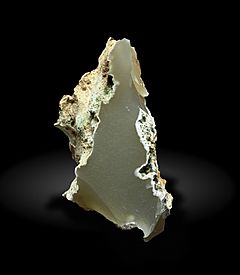Moganite facts for kids
Quick facts for kids Moganite |
|
|---|---|

|
|
| General | |
| Category | Tectosilicate, quartz group |
| Formula (repeating unit) |
SiO2 |
| Strunz classification | 4.DA.20 |
| Dana classification | 75.01.04.02 |
| Crystal symmetry | I2/a |
| Identification | |
| Color | Grey |
| Crystal habit | Massive |
| Crystal system | Monoclinic |
| Mohs scale hardness | 6 |
| Luster | Earthy, dull |
| Streak | White |
| Diaphaneity | Transparent |
| Optical properties | Biaxial |
| Refractive index | nα = 1.524 nγ = 1.531 |
Moganite is a type of mineral that was found in 1976. It is an oxide mineral, which means it contains oxygen and at least one other element. For Moganite, that other element is silicon, so its chemical formula is SiO2. This is the same chemical makeup as quartz.
Moganite was first found in a place called Barranco de Medio Almud. This area is in the town of Mogán on the island of Gran Canaria, which is part of the Canary Islands in Spain. The mineral was later named "Moganite" after the town of Mogán.
Contents
About Moganite
Moganite has the same chemical ingredients as quartz. However, its internal crystal structure is different. Think of it like two buildings made from the same bricks but with different designs.
Discovery and Recognition
When Moganite was first found, scientists thought it might just be a new form of silica. Silica is a common compound found in many minerals.
In 1994, the International Mineralogical Association (IMA) first decided that Moganite was not a unique mineral. They thought it was too similar to quartz.
But later studies showed that Moganite was indeed different. So, in 1999, the IMA changed its mind and officially accepted Moganite as a real and distinct mineral.
Where Moganite is Found
Moganite is mostly found in dry places. Besides Gran Canaria in Spain, it has also been found near Lake Magadi in Africa.
Scientists have reported finding Moganite in many other places too. These include different parts of Europe, India, and the United States.
What Moganite Looks Like
Moganite has certain physical traits that help identify it.
- Hardness: It has a Mohs hardness of about 6. This means it's hard enough to scratch glass.
- Luster: It has a dull or earthy luster. This describes how light reflects off its surface.
- Color: Moganite usually appears as a semi-transparent gray color.
See also
 In Spanish: Moganita para niños
In Spanish: Moganita para niños

